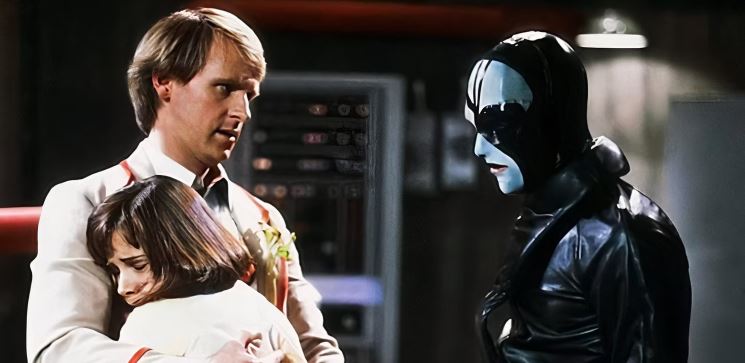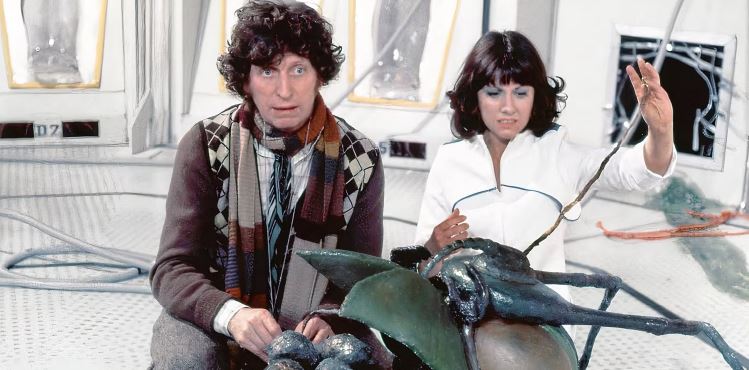The first series of Doctor Who featuring the Fifteenth Doctor was packed with all the staples of the long-running show, including comedy, nail-biting tension, creepy stories and historical jaunts. But in a debut run shorter than most of his predecessors, Ncuti Gatwa’s Time Lord also packed in a few surprises, like a musical episode and an emphasis on myth and fantasy.
Series 14’s two-part finale saw the shock, if highly anticipated, comeback of classic series villain Sutekh, whose only previous appearance had been almost 50 years before. Fans had waited a long time to see ‘The One Who Waits,’ and the show served up a fascinatingly backward-looking finale — even including footage of the classic story “Pyramids of Mars.” That call-back is the perfect opportunity for new fans who’ve grown to love the Fifteenth Doctor’s humor, empathy, and sense of fun to jump back in time and watch the classic series.
Heading Back In Time To Doctor Who’s Classic Series

Doctor Who’s classic years ran from 1963 to 1989, with annual seasons featuring the adventures of seven Doctors. A one-off TV movie made for US TV featuring Paul McGann’s Eighth Doctor was broadcast in 1996 and included in the era. Many of the elements established during the classic years remain with the show, not least the Doctor, companions, and TARDIS disguised as a police box. Since it returned to screens in 2005, the show has been run by childhood fans of the show who have skillfully updated key elements for current audiences. Still, viewers returning in time must brace themselves for some crucial differences.
Firstly, there is a lot of classic Doctor Who: over 300 stories across 26 seasons and a movie. In addition, the classic series very rarely had single-episode stories. Most are multi-episode serials, telling a story over two to 12 installments. This gave the show a reputation for cliffhangers that the modern series has kept going when it can. Doctor Who’s seasons, each comprising several stories, covered a large part of the year when broadcast, making a vastly different viewing experience to the recent 8-part series.
Naturally, the serial format means stories are often paced slower and sometimes packed with filler. That doesn’t mean they are any less riveting or entertaining: Plenty of episodes in modern Doctor Who could have benefitted from the feature-length running time of classic-era stories. Viewers new to this period should also remember that the show’s first seven years were transmitted in black and white. In 2023, “The Daleks in Color” was the first serial from that time to be colorized in a special new cut.
Then there’s the tragic case of the show’s many missing episodes, which the BBC, the show’s producer, deliberately scrapped when the idea of home media and on-demand wasn’t even dreamed of. The BBC is steadily animating these missing episodes, meaning that one day, there should be a complete era for fans to watch. Fortunately, the hundreds of surviving episodes mean any fan of the Fifteenth Doctor eager to delve into Doctor Who’s impressive back catalog is in for a treat.
The Classic Stories Fifteenth Doctor Fans Have To Watch

The Fifteenth Doctor won many hearts as he effortlessly slotted into a long lineage of Doctors while finding his own distinctive style. Style is the word as he’s one of the smoothest Doctors to pilot the TARDIS. He happily changes and mixes up his sharp costumes for every adventure, and forms relationships easily. He’s notably more open to sharing personal information than some of his predecessors, for instance, when he opened up to old friends like Kate Stewart in the series finale.
The Fifteenth Doctor is full of energy and keen to keep exploring and discovering new things — a defining character trait that masks another. This highly empathetic incarnation of the Doctor means every story is an emotional roller coaster, but Fifteen has an urge to leap onto the next adventure when the pain and loss get too close. Some of these traits are shared with his predecessors, but so are the dilemmas and predicaments he finds himself in. Fans will find plenty of links to Series 14 in these classic stories.
“Pyramids Of Mars” (4 Episodes, Season 13, 1975)

This one’s inevitable, given the twists and turns of the Series 14 finale. In 1975, the Fourth Doctor and companion Sarah Jane Smith first met Sutekh in an adventure that fused sci-fi with the gothic horror of The Mummy. This is a chance for viewers to see Osiran before his evolution when he was more of an alien dictator with god delusions.
The most recent appearance also dropped the classic horror elements of an adventure that sees Tom Baker’s Doctor, at the peak of his powers, take on one of the greatest threats he’s ever encountered. A trip to the future that allows the Doctor to demonstrate the consequences of time travel to Sarah Jane is a highlight, inspiring a similar scene in “The Devil’s Chord.”
“The Greatest Show In The Galaxy” (4 episodes, Season 25, 1988)

Going up against the gods quickly became a theme for the Fifteenth Doctor. It’s bold, pitting the Doctor against apparently impossible odds, but he isn’t the first incarnation to face apparently all-powerful enemies. In the season that marked the show’s quarter-century, the Seventh Doctor and Ace found themselves in an irresistibly surreal adventure as they ran into the Psychic Circus.
Behind the danger of the Big Top lurked the Gods of Ragnarok, a trio of powerful extra-dimensional entities that fed off entertainment and quickly dispatched anyone who didn’t amuse them. The ‘family’ of this off-beat story is a creepy predecessor to the dynasty of gods seen in the recent series.
“The Caves Of Androzani” (4 Episodes, Season 21, 1984)

Ncuti Gatwa’s Fifteenth Doctor is young, vibrant, and dashing, but so was Peter Davison’s Fifth Doctor. The show’s first ‘Young Doctor’ injected breathless adventure into his stories, often from a TARDIS packed with companions. By the end of his tenure, he had one companion, American student Peri Brown, returning the show to the template of Doctor and female companion that has remained, mostly, the norm.
“Caves of Androzani” isn’t just the Fifth Doctor’s final and finest hour but one of the best-regarded stories in Doctor Who’s history. There are no gods in these four episodes, but an all-too-human drama of scheming and revenge featuring the desperate death-facing dilemmas of “Boom” and the duplicate deception of “Rogue.”
“The Curse of Fenric” (4 Episodes, Season 26, 1989)

This late classic foreshadows Series 14’s tangle with god-like beings and mysterious links to the Doctor’s friends. In the classic era’s final full year, the Seventh Doctor revealed a manipulative and dark side when he took his companion Ace into stories that revolved around her family and history.
“The Curse of Fenric” takes place during WW2, when an ancient game between the Doctor and a menacing evil from before time reaches its final moves. Suggested to be a Lovecraftian-style Elder God, Fenric draws on his followers, or wolves, from Earth’s ancient past and a possible dystopian future where the remaining humans have evolved into aquatic vampires. Things darken when Ace is revealed to be one of those wolves.
“Doctor Who And The Silurians” (7 Episodes, Season 7, 1970)

Although the Doctor doesn’t appear much in “73 Yards,” he does namecheck the war between the land and the sea — the title confirmed at SDCC 2024 for the Doctor Who spin-off set to feature old foes, the Sea Devils. The cousins of those earth reptiles, the subterranean Silurians, first appeared in this epic serial set early in the Third Doctor’s exile to Earth.
It’s a melancholy story, where the Doctor’s new role as scientific advisor to UNIT proves to be powerless against the military approach to protect humanity at all costs. If fans want to watch a scene that helped influence the painful and emotional moments of powerlessness at the end of “Dot and Bubble,” this is essential.
“The Dalek Invasion of Earth” (6 Episodes, Season 2, 1964)

The Fifteenth Doctor has yet to face off against his greatest enemies, but fans can rest assured that he will. The Daleks caused a wave when they first appeared in the show’s second story, and their return the following year upped the ante as the Daleks succeeded in invading Earth… For a while.
The idea of family is important in “The Dalek Invasion of Earth,” and of course, it became a recurring theme in Series 14. The Fifteenth Doctor opened up about his family as he became convinced that his estranged granddaughter Susan might be involved. It was at the end of this Dalek serial from the show’s second year that Susan left her grandfather to stay with her new fiancee, David, and help rebuild the planet after the pepperpots’ defeat.
“The Ark in Space” (4 Episodes, Season 12, 1975)

There are no space babies in this classic episode, but it does find a freshly regenerated Fourth Doctor tackling a mysterious and invasive force on a space station crucial to humanity’s future.
It was very early in the tenure of an all-time favorite Doctor, but this story’s mix of horror and sci-fi set a lasting legacy. Penned by Robert Holmes, one of the greatest writers of the classic series, its impact can be felt throughout the modern era. Fans will recognize similar space-bound chills bound up with the Doctor’s immense admiration for humanity (for all their faults) in the first adventure of Series 14.
